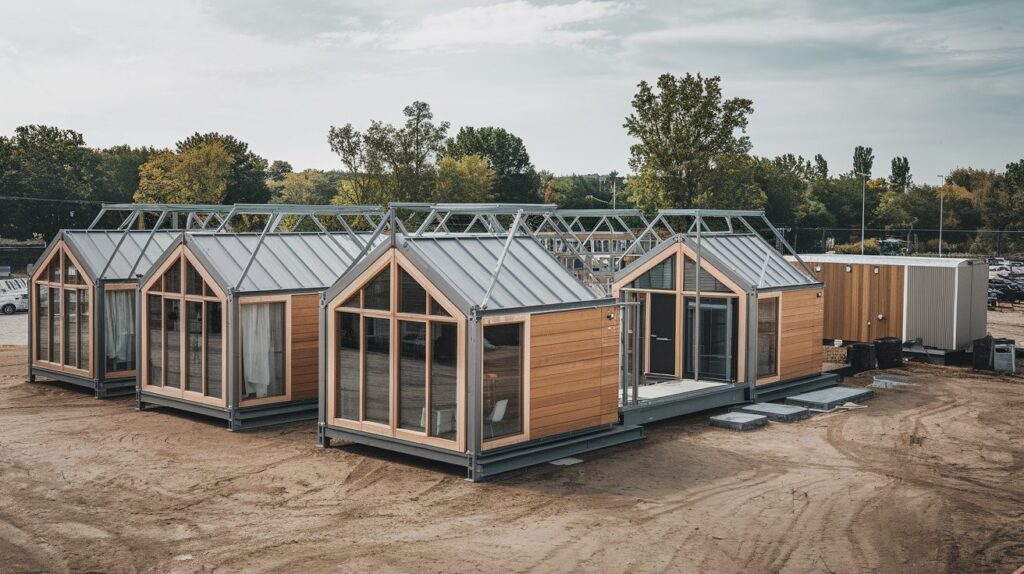
Modular Co-Living Spaces: The Future of Sustainable Living
Modular co-living spaces are rapidly gaining popularity as an innovative solution to urban housing challenges. These spaces offer a flexible, sustainable, and cost-effective way to live in densely populated areas. With increasing urbanization and the rising cost of living, more people are turning to modular living arrangements as an alternative to traditional housing.
In this article, we will explore everything you need to know about modular co-living spaces, including their benefits, features, and how they are shaping the future of urban living. Whether you’re a homeowner considering a switch to modular living or someone interested in sustainable housing solutions, this guide will provide valuable insights.

What Are Modular Co-Living Spaces?
Modular co-living spaces are residential buildings made up of prefabricated modules that are assembled on-site. These modular units can be customized to create various configurations, offering flexibility in design and layout. This approach to construction allows for faster building times and reduced waste, aligning with sustainable housing principles.
The Rise of Co-Living
The concept of co-living involves sharing living spaces with others to cultivate a sense of community and reduce individual living costs. This model is particularly appealing in urban areas where space and housing are at a premium. Modular co-living spaces take this idea further by incorporating modular construction methods to create adaptable and energy-efficient homes.
Benefits of Modular Co-Living Spaces
Affordability
One of the most significant advantages of modular co-living spaces is their affordability. By utilizing prefabricated materials and efficient construction techniques, these spaces typically cost less to build than traditional homes. This affordability makes it easier for individuals, especially young professionals and students, to access quality housing.
Flexibility and Customization
Modular homes offer unparalleled flexibility in design. Whether you need additional rooms, a larger living area, or a modified layout, modular designs can accommodate these changes. This flexibility allows residents to tailor their living spaces to their needs, ensuring a personalized and comfortable home environment.
Sustainability
Sustainability is a core component of modular co-living spaces. These constructions aim to minimize environmental impact by using sustainable materials and minimizing waste during the construction process. As a result, modular homes often have a smaller carbon footprint compared to traditional housing.
For more information on environmentally friendly building practices, check out our dedicated section on green modular construction.
Features of Modular Co-Living Spaces
Smart Home Integration
The integration of smart home technology is a common feature in modular co-living spaces. These technologies enable residents to control lighting, heating, and security systems remotely, enhancing convenience and reducing energy consumption.
Shared Amenities
Co-living spaces often include shared amenities such as kitchens, lounges, and workspaces. These communal areas encourage interaction among residents, fostering a sense of community and collaboration.
Compact and Efficient Design
Designed for efficiency, modular homes make the most of available space. Clever storage solutions and multi-functional furniture help maximize living areas without sacrificing comfort or style. Explore the potential of such designs in our article on tiny modular homes.
Challenges and Considerations
Regulatory Hurdles
Despite their benefits, modular co-living spaces can face regulatory challenges. Zoning laws and building codes vary by region, and navigating these regulations can be complex. Prospective builders must ensure compliance with local laws to avoid potential legal issues.
Community Fit
Achieving a harmonious community fit is crucial in co-living arrangements. It’s important for developers to consider the density, layout, and amenities of a modular co-living space to ensure it meets the needs of its residents.
Maintenance
Regular maintenance is necessary to keep modular homes in good condition. Residents and management teams must work together to ensure that all shared facilities and personal units are well-maintained.
The Future of Modular Co-Living Spaces
As cities continue to grow, the demand for innovative housing solutions like modular co-living spaces will likely increase. These spaces are poised to become a significant part of urban living, offering sustainable, affordable, and customizable solutions.
If you’re interested in exploring other modern housing solutions, visit our section on low-carbon housing.

FAQs on Modular Co-Living Spaces
Are modular co-living spaces environmentally friendly?
Yes, modular co-living spaces are designed with sustainability in mind. They often use recycled materials and minimize waste, resulting in a lower environmental impact compared to traditional construction methods.
Can I customize a modular home?
Yes, you’ll find that modular homes offer significant design flexibility. Whether you want to alter the layout, add rooms, or implement specific features, modular construction allows for customization based on your needs and preferences.
How do modular homes compare in cost to traditional homes?
Modular homes are generally more cost-effective due to efficient construction processes and the use of prefabricated materials, making them an attractive option for budget-conscious individuals.
This article contains affiliate links. We may earn a commission at no extra cost to you.